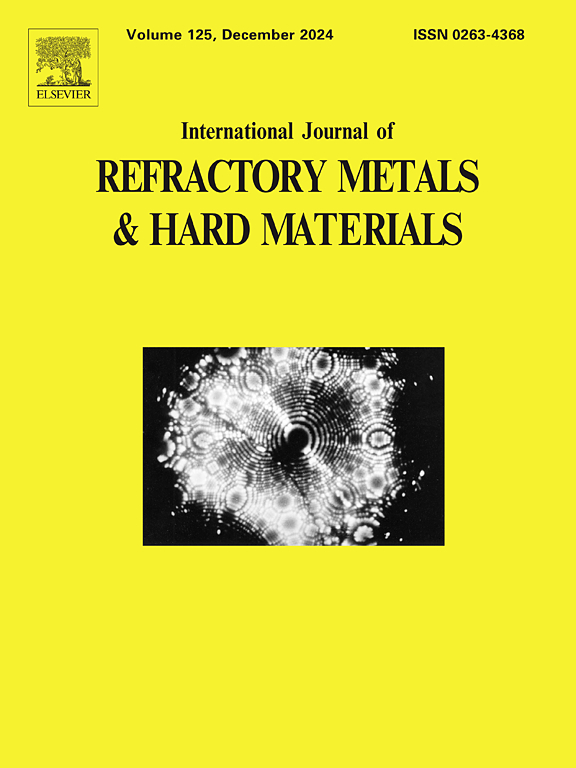On the comprehensive performance enhancement of polycrystalline diamond compact by initial diamond particle ratio optimization and cobalt removal treatment
IF 4.2
2区 材料科学
Q2 MATERIALS SCIENCE, MULTIDISCIPLINARY
International Journal of Refractory Metals & Hard Materials
Pub Date : 2025-05-12
DOI:10.1016/j.ijrmhm.2025.107226
引用次数: 0
Abstract
The global oil and gas exploration was towards deep and ultra-deep formations. The complex drilling environment of the deep formations put forward higher requirements on the performance of drill bit materials. As the most commonly used drill bit materials in oil drilling, the performance of polycrystalline diamond compact (PDC) directly affected the drilling efficiency, drilling quality and drilling cost. Extensive researches showed that the diamond particle ratio optimization and cobalt removal treatment could highly improve the performance of PDC cutters. Therefore, in this paper, high performance PDCs with trimodal diamond particle size was prepared and the cobalt binder in polycrystalline diamond table was removed by acid leaching methods. The performance of cobalt-removed trimodal particle size PDC samples was compared with cobalt-removed single particle size PDC to study the influence of particles size on the performance of cobalt removal PDC. The performance test results showed that the abrasion resistance of trimodal diamond particle size PDC was improved by two-fold after the cobalt removal treatment, and compared with single particle size PDC after cobalt removal, it also was improved by 33 %. After diamond particle ratio optimization, the impact toughness of PDCs was also improved by up to 110.5 %.
初始金刚石颗粒比优化及脱钴处理对聚晶金刚石致密材料综合性能的提高
全球油气勘探正朝着深层和超深层方向发展。深层复杂的钻井环境对钻头材料的性能提出了更高的要求。聚晶金刚石压片(PDC)作为石油钻井中最常用的钻头材料,其性能直接影响到钻井效率、钻井质量和钻井成本。大量研究表明,优化金刚石颗粒比和除钴处理可以显著提高PDC切削齿的性能。因此,本文制备了具有三峰金刚石粒度的高性能pdc,并采用酸浸法去除聚晶金刚石表中的钴粘结剂。将脱钴三模态粒径PDC样品的性能与脱钴单粒径PDC样品的性能进行比较,研究粒径对脱钴PDC性能的影响。性能试验结果表明,经过脱钴处理后,三模态金刚石粒度PDC的耐磨性提高了2倍,与脱钴后的单粒径PDC相比,其耐磨性也提高了33%。金刚石颗粒配比优化后,pdc的冲击韧性也提高了110.5%。
本文章由计算机程序翻译,如有差异,请以英文原文为准。
求助全文
约1分钟内获得全文
求助全文
来源期刊
CiteScore
7.00
自引率
13.90%
发文量
236
审稿时长
35 days
期刊介绍:
The International Journal of Refractory Metals and Hard Materials (IJRMHM) publishes original research articles concerned with all aspects of refractory metals and hard materials. Refractory metals are defined as metals with melting points higher than 1800 °C. These are tungsten, molybdenum, chromium, tantalum, niobium, hafnium, and rhenium, as well as many compounds and alloys based thereupon. Hard materials that are included in the scope of this journal are defined as materials with hardness values higher than 1000 kg/mm2, primarily intended for applications as manufacturing tools or wear resistant components in mechanical systems. Thus they encompass carbides, nitrides and borides of metals, and related compounds. A special focus of this journal is put on the family of hardmetals, which is also known as cemented tungsten carbide, and cermets which are based on titanium carbide and carbonitrides with or without a metal binder. Ceramics and superhard materials including diamond and cubic boron nitride may also be accepted provided the subject material is presented as hard materials as defined above.

 求助内容:
求助内容: 应助结果提醒方式:
应助结果提醒方式:


